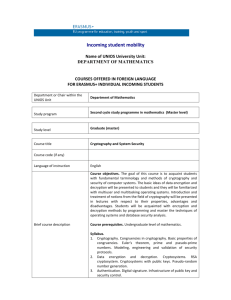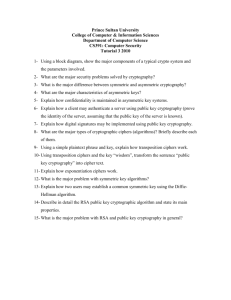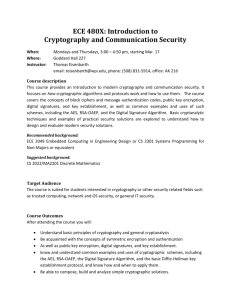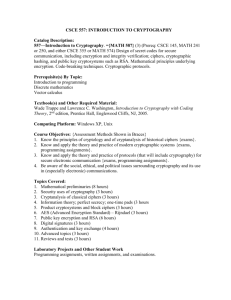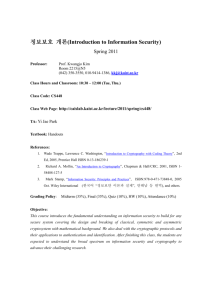in clear (readable)
advertisement
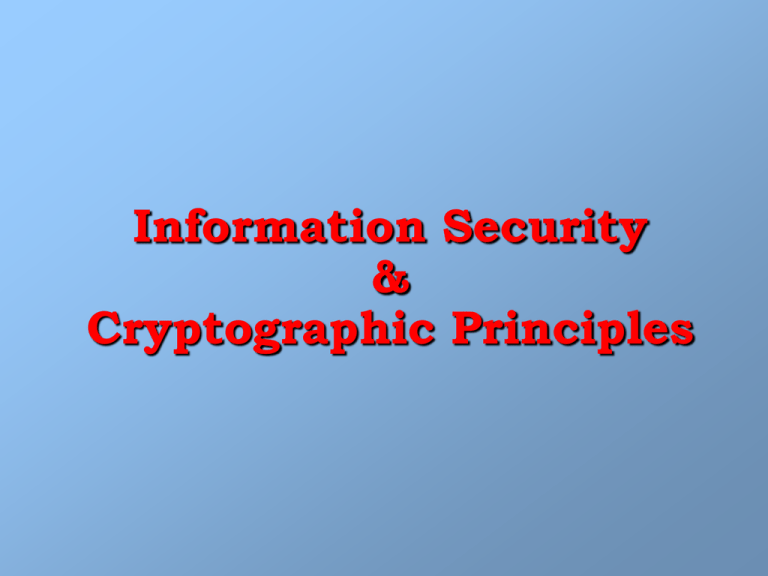
Information Security & Cryptographic Principles Infosec and Cryptography Subjects / Topics : 1. 2. 3. 4. 5. Introduction to computer cryptography Single key cryptographic algorithms Public key cryptographic algorithms Crypto Applications Business Continuity Basic Problem Intranet Bob Extranet Internet Alice There are Confidence and Trust Issues … Multiple Security Issues Privacy Authentication Interception Spoofing Integrity Non-repudiation Claims Not sent Modification not received Proof of parties involved Information Security Confidentiality Integrity Availability Security Services Integrity Information has not been altered Confidentiality Content hidden during transport Authentication Identity of originator confirmed Non-Repudiation Originator cannot repudiate transaction Data Confidentiality Some confidential text (message) in clear (readable) form Cryptography Some confidential text (message) in clear (readable) form Someconfid entialtext essage) in clear Encryption Cryptography Some confidential text (message) in clear (readable) form Someconfid entialtext essage) in clear Decryption Crypto Transformations Some confidential text (message) in clear (readable) form Someconfi Entialte essage) in clear Crypto Transformations Some confidential text (message) in clear (readable) form Someconfi Entialte essage) in clear Parameterization Some confidential text (message) in clear (readable) form Crypto key Someconfid Someconfid Someconfid entialtext Someconfid entialtext entialtext Someconfi essage) entialtext Entialte essage) essage) essage) in clear essage) in clear in clear in clear in clear Infosec and Cryptography Subjects / Topics : 1. 2. 3. 4. 5. Introduction to computer cryptography Single key cryptographic algorithms Public key cryptographic algorithms Crypto Applications Business Continuity Single Key Crypto Encryption Someconfid Entialtext essage) in clear Some confidential text (message) in clear (readable) form Crypto key Decryption Design . . . ? How to design good cryptographic systems ? What does it mean good crypto system ? Principles 1. 2. 3. 4. 5. 6. Simple for users Complicated for intruders Public algorithm Secret key Large number of combinations Special properties Other Symmetric Algorithms 1. AES 2. IDEA 3. Triple - DES 4. RC-2 5. RC-4 6. Blowfish Infosec and Cryptography Subjects / Topics : 1. 2. 3. 4. 5. Introduction to computer cryptography Single key cryptographic algorithms Public key cryptographic algorithms Crypto Applications Business Continuity Secret Key Systems Encryption Someconfi entialtext essage) in clear Some confidential text (message) in clear (readable) form Crypto key Decryption Key Exchange ? Public Key Cryptography Encryption Key 2 Some confidential text (message) in clear (readable) form Someconfi entialtext essage) in clear Key 1 Decryption Public Key Cryptography Bob Alice MSG Encryption tia Decryption MSG Bob Private Alice Private Bob Public Alice Public Digital Signature … Authentication … Non-Repudiation Public Key Cryptography Bob Alice MSG Encryption tia Bob Private Decryption MSG Alice Private Bob Public Alice Public Confidentiality Symmetric and Asymmetric Encryption m Symmetric: Faster than asymmetric, hard to break with large key, hard to distribute keys, too many keys required, cannot authenticate or provide nonrepudiation. m Includes: DES, Triple DES, Blowfish, IDEA, RC4, RC5, RC6, AES Symmetric and Asymmetric Encryption m Asymmetric cryptography: Better at key distribution, better scalability for large systems, can provide authentication and non-repudiation, slow, math intensive m Includes: RSA, ECC, Diffie Hellman, El Gamal, DSA, Knapsack, PGP Infosec and Cryptography Subjects / Topics : 1. 2. 3. 4. 5. Introduction to computer cryptography Single key cryptographic algorithms Public key cryptographic algorithms Crypto Applications Business Continuity Crypto Applications 1. Digital signature 2. Digital enveloping 3. Digital certificates 4. Secret key exchange Digital Signature A Digital Signature is a data item that vouches for the origin and the integrity of a Message Intranet Extrane t Bob Internet Alice Digital Signature Message Digest Algorithm Message Digest Algorithm Hash Function Digest Private Key Hash Function Public Key Encryption Decryption Signature Expected Actual Digest Digest Signer Channel Receiver Digital Signature “Real Identity” of the Signer. Why should I trust what the Sender claims to be ? Moving towards PKI … Digital Certificate A Digital Certificate is a binding between an entity’s Public Key and one or more Attributes related to its Identity. The entity can be a Person, an Hardware Component, a Service, etc. A Digital Certificate is issued (and signed) by someone : Usually the issuer is a Trusted Third Party Digital Certificate CERTIFICATE Subject Issuer Subject Public Key Issuer Digital Signature Digital Certificate How are Digital Certificates Issued? Who is issuing them? Why should I Trust the Certificate Issuer? How can I check if a Certificate is valid? How can I revoke a Certificate? Who is revoking Certificates? Moving towards PKI … Infosec and Cryptography Subjects / Topics : 1. 2. 3. 4. 5. Introduction to computer cryptography Single key cryptographic algorithms Public key cryptographic algorithms Crypto Applications Business Continuity Business Continuity and Disaster Recovery m Businesses are more susceptible to failure after a disaster m Goal • To minimize disaster aftermath and ensure resources, personnel, and business processes resume m By • Planning measures • Backing up data and hardware • Getting the right people in place m Requirements • Management support • Driving the project, top-down approach • Must understand value of investing in BCP – Returns can be priceless Business Continuity Steps m Steps • • • • • • • m Develop the continuity planning policy statement Conduct the business impact analysis (BIA) Identify preventive controls Develop recovery strategies Develop the contingency plan Test the plan and conduct training and exercises Maintain the plan Understanding the Organization Business Continuity Plan Business Impact Analysis BIA • Considered a functional analysis • Team collects data in variety of ways • Maps out following characteristics: – Maximum tolerable downtime – Operational disruption and productivity – Financial considerations – Regulatory responsibilities – Reputation • Understand the variety of possible threats • Must go through all possible scenarios Questions


